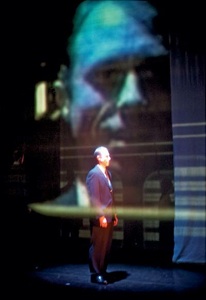The play
follows two black kids through the 1980s from school to near-stardom in
the boxing ring, where they are pitted against each other. Leon, the
natural talent, rises quickly, but is beaten finally by his friend, with
the more professional management,Troy. On the way, Leon is forced to
give up the (white) boss’s daughter and is derided as an Uncle Tom for
his devotion to the racist boss. At the end, the gym to which Leon has
been loyal goes under, in part because Leon could not win his fight, but
also because the boss, Charlie, bet everything on the stock market and
lost it in the crash.
This is a pretty terrific play. Roy
Williams combines grace and power. The power comes in the muscular way
his dialogue, situation and characters claim the stage; there are some
stunning set-piece monologues, here played in the boxing ring, where the
characters describe fights. But throughout there’s a compelling,
plausible set of bare-knuckle rows between the characters. He creates
clear, strong psychological lines and keeps the situations wittily sharp
but also unabashedly emotional. But then he’s graceful too. The play
elegantly skips from time to time, situation to situation; characters
are brought in and they leave, fights are won and lost; he keeps deft,
he keeps changing his footing (sorry, it’s hard to avoid this critical
cliche bollocks, but I’ll stop now). There are duologues, monologues,
three-handers, action scenes; he is both a crisply traditional writer
and a fluidly challenging one. Conventional because there are rounded
characters, clear plotlines, twists, turns and intrigue, a clear climax
and even a scène à faire when the two boys -
actually a bit implausibly - have a moment of reconciliation. But he’s
challenging because of the variety of storytelling means. And you think
that the climax will be pitting the white boxer, Tommy, who is being
championed early, but leaves for a rival promoter, against Leon.
Instead, he meets the entirely unfancied Troy.
(Basic dramaturgical stuff: starts with a
Brixton riot, which suggests 1981 or 1985 and ends with a stock market
crash which is 1988. I got the sense the play only covered 2-3 years,
but then at one point they play Shalamar’s ‘I Can Make You Feel Good’
which was a hit in 1982 and Spandau Ballet’s ‘Gold’ from 1983. Plus, the
play was clearly trying to suggest an epic journey through an era. I’m
guessing it covers 7 years then.)
Two things struck me about this show.
First, liveness. Williams creates dialogue that sits squarely on the
stage, claims it. It’s writing in the present tense, absolutely. This is
enhanced by the concentration of the play on boxing, which is entirely
about the present tense, the unpredictability of it (football’s the same
- as in his Sing Yer Heart Out For The Lads,
but with any team you’ve heard of, the score is already known). Very
smartly Sacha Wares has placed the entire play in and around the boxing
ring and the play benefits hugely from this. There are very ‘live’
things going on in this production too. An early monologue by Leon is
performed in the ring with a skipping rope; there is simply a level of
unfakeable physical skill that is impressive and not the same as acting.
In other words, it’s live; at one point, the actor actually missed his
footing and had to regather his rhythm with the rope. In a way this just
enhanced it. Then later, Troy comes and does an even harder, faster
skip with the rope; this is how you know he’s going to win, but, more
important, it is how you learn that the kid can really box. One other
curious bit of liveness; last night, among the celebrity audience (we
spotted Nigel Havers, and there were rumours of David Hare) was Lenny
Henry. One of the first lines of the play is the racist gym-owner
telling Troy, ‘oi! Lenny Henry!’ There was a frisson in our area of the
stalls (and Lenny mugged at us to emphasise the point).
The second thing is the ring. I like seeing the Royal Court transformed. I’ve seen it a few times; the thrust pushed out for The Kitchen in 1994, Roy Williams’s Fallout in 2003, and again for Stoning Mary in 2005. Sacha Wares entirely transformed the space for Mike Bartlett's My Child in 2007. The Sarah Kane season in 2001 split the main house into two spaces for Crave and 4.48 Psychosis. I gather Wig Out!
turned the downstairs into a club with a central catwalk. The building
was originally a theatre, then became a cinema, then was bomb-damaged.
When the English Stage Company took over the Court in 1955, they ripped
out the proscenium, extended the stage; in 2000, the whole building was
redesigned, with a huge underground bar dug out under Sloane Square and
the plaster stripped back to reveal brick and iron trelliswork. For a
solid, modest, late-nineteenth-century Italianate pastiche theatre, it’s
been immensely flexible. It has a magic size that stacks the audiences
vertically against a tall proscenium, giving no one a distant view and
just about guaranteeing an art-house crowd can fill it most nights.
But there’s a weird naivety that grips
some theatremakers when they start reconfiguring the auditorium. There’s
a view around - which has some validity - that the basic
late-nineteenth-century actor-audience relation fosters passivity in the
audience, a certain demand for illusionistic realism, and that we have
naturalised a middle-class set of social and cultural behaviours as How
To Watch Theatre; today’s audiences, grown up on interactivity and with
short attention spans, need a different approach.
First, I’d challenge all of those; I
don’t think silence is the same as passivity; the theatre is barely ever
illusionistic (illusions suggest we are tricked into believing things -
and we never really believe the fictions are there); third, the history
of British theatregoing suggests that a huge range of different
audience behaviours is permitted within the basic pros-arch end-on
theatre form. Music Hall, Pantomime, lots of stand-up, rock gigs, and
more. In none of these would you say the audience was quietly passive;
lastly, I don’t believe we are any more ‘interactive’ or that our
attention spans are any shorter than previously. It’s lazy journalistic
thinking (the MTV generation, etc.) but you hear it said whenever
anything like a promenade production or a bit of multimedia or when the
auditorium gets restructured.
Now, I have no reason to think these
things were behind Sacha Wares and Miriam Buether’s decision to turn the
Court stage into a boxing ring; I suspect there may have been a desire
to turn us into a boxing crowd. There may have been discussion of
Brecht, who thought - very early on - that the boxing audience was his
perfect engaged, thinking audience. Certainly, the entrance of the two
boxers through the audience before the Big Fight suggested a bit of
that.
But this never works. The aim is to
strip through the falseness, the pretence, the etiquette, the class; but
you just end up more self-conscious, more inhibited, feeling more
ridiculous if you shout out (even if you do), more bound by the
conventions of theatregoing. I liked the staging but it certainly didn’t
make me feel more engaged in the story
than a straight proscenium production would have done. I didn’t feel the
atmosphere of a boxing match was evoked, in any way; despite the
liveness of the physical skill, I knew the outcome of the game was set
and its progress choreographed. It would have been possible to do
something like Ayckbourn in Sisterly Feelings
where there are two endings, but what would have happened then? It’s
actually more deterministic than the single track; it implies that there
are only two possible options, whereas with on track, it doesn’t
suggest options aren’t open, it just says ‘this is what you’re watching’
(just as we experience a single track of life). So, if we were to start
yelling encouragement to one of the boxers, we’d be play-acting. And,
hey, that might be fun and cathartic and so on, but it still seems to me
novelty theatre.
All of that to say, this is a smart play, written deceptively: it is very accessible and broad in its appeal, but it’s very precise and elegant too.







![photo[1].jpg](https://images.squarespace-cdn.com/content/v1/513c543ce4b0abff73bc0a82/1362919072201-PZO854G4SEB794DVOEI8/photo%5B1%5D.jpg)
